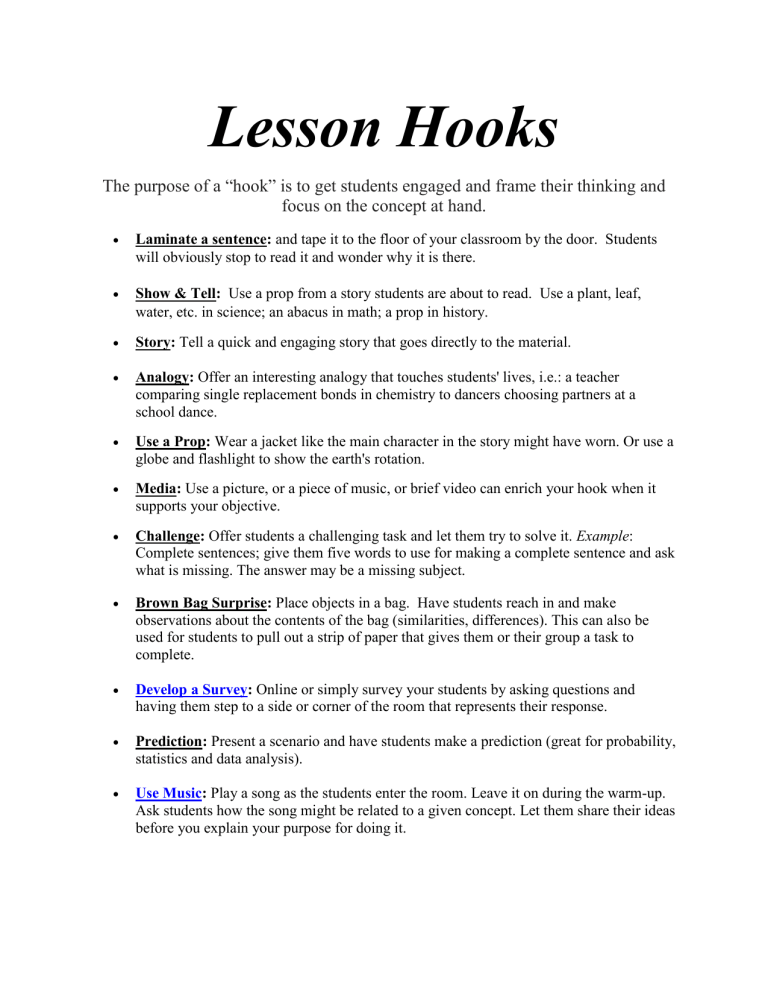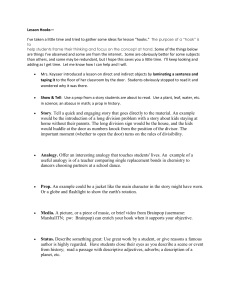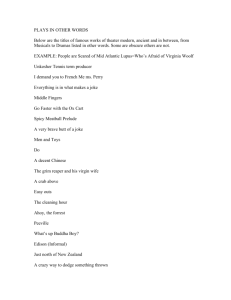
Lesson Hooks The purpose of a “hook” is to get students engaged and frame their thinking and focus on the concept at hand. Laminate a sentence: and tape it to the floor of your classroom by the door. Students will obviously stop to read it and wonder why it is there. Show & Tell: Use a prop from a story students are about to read. Use a plant, leaf, water, etc. in science; an abacus in math; a prop in history. Story: Tell a quick and engaging story that goes directly to the material. Analogy: Offer an interesting analogy that touches students' lives, i.e.: a teacher comparing single replacement bonds in chemistry to dancers choosing partners at a school dance. Use a Prop: Wear a jacket like the main character in the story might have worn. Or use a globe and flashlight to show the earth's rotation. Media: Use a picture, or a piece of music, or brief video can enrich your hook when it supports your objective. Challenge: Offer students a challenging task and let them try to solve it. Example: Complete sentences; give them five words to use for making a complete sentence and ask what is missing. The answer may be a missing subject. Brown Bag Surprise: Place objects in a bag. Have students reach in and make observations about the contents of the bag (similarities, differences). This can also be used for students to pull out a strip of paper that gives them or their group a task to complete. Develop a Survey: Online or simply survey your students by asking questions and having them step to a side or corner of the room that represents their response. Prediction: Present a scenario and have students make a prediction (great for probability, statistics and data analysis). Use Music: Play a song as the students enter the room. Leave it on during the warm-up. Ask students how the song might be related to a given concept. Let them share their ideas before you explain your purpose for doing it. Science Experiments: Conduct an experiment that illustrates a concept. For example, use water to fill 3D containers to illustrate volume or help students make a recipe using benchmark measurements. Vocabulary connections: Give students a group of words related to the lesson…have them guess the topic or find the word that doesn’t fit in the group. Or, play Vocabulary Games News: Bring in a newspaper article or online news clip that addresses an area of interest or importance to your students. Skit/ Dress-Up: Give students roles and have them act out a skit. Or, you can come in dressed for a given role. It can be as simple has wearing a sports jersey if you’re writing algebraic equations on a person buying a $75 ticket and x number of hot dogs at a game. Play a Game: Jeopardy for trivia or quick math facts game, such as ‘around the world’ . Writing Prompt: Ask students to write everything they know about an upcoming learning objective, or present them with a prompt that is closely related to the learning objective. Graphic Organizers: Example: KWL, Spider Map, Sequence Chart, etc… Tell a Joke: Using humor is a sure way to engage your students. Telling an initial joke & then probing students or explaining to students why the joke is humorous can be a fun way to introduce a lesson Brainstorm: Your students possess a great deal of contextual knowledge around a variety of topics and issues related to classroom content. Tapping into this prior to teaching a new concept may be an effective method for setting the stage for new learning. Scavenger Hunt: Present student with clues about the learning objective they will be taking on for the day.


